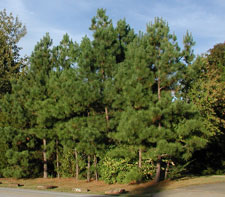Resource Library
Plant of the Week: Pine, Loblolly
The University of Arkansas System Division of Agriculture does not promote, support or recommend plants featured in "Plant of the Week." Please consult your local Extension office for plants suitable for your region.
Plant of the Week
Loblolly Pine
Latin: Pinus taeda

On my window sill sits a fossilized seashell extricated from a roadside cut in south Arkansas’ gulf coastal plain. I was drawn to this location by parallel bands of penstemons I noticed marching across a pasture in straight rows.
On inspection, it became obvious the penstemons were there because of calcium secreted from a series of ancient drifts of now fossilized mollusk shells. This low lying land makes up about a third of Arkansas and is home to our state tree, the loblolly pine.
Loblolly pine (Pinus taeda) was selected as the Arkansas state tree in 1939. It was a fitting choice because this species not only grows over a large part of the state it was and remains the most significant timber species in the state. Its native range is from New Jersey to Texas and includes 14 southern states. In all these states its range is defined by the extent of the coastal plain.
Loblolly pines are a three-needle pine with the needles reaching 5 to 8 inches long. Trees are fast-growing with a strong ventricle form. The lower limbs are intolerant of shading and drop while young. Trees in open situations maintain limbs in a broadly pyramidal form, but eventually lower limbs drop, concentrating foliage at the top of the tree.
In cultivation, most trees are in the 50- to 70-foot tall range. Loblolly, also sometimes called the old-field pine, is a prolific reseeder and quickly establishes itself along road cuts and on abandoned land.
When you see a pine in Arkansas, it’s probably a loblolly. In the piney woods of the southern counties it’s planted by the millions on 6-foot centers like a crop of corn. This close spacing ensures a solid stand of pines will become established, shading out hardwoods and producing the famously tall, branch-free boles.
After about a decade, half of the trees are cut for pulpwood, releasing the remaining trees for a spurt of growth. Depending on the strategy used, additional thinning cuts may follow. Usually, all trees are cut by the time they reach 35 to 40 years of age.
But these trees are just saplings compared to the potentiality of the species. Almost all of the trees of the virginal Arkansas forest are gone, but fortunately a few were preserved in the Levi Wilcoxon Demonstration Forest in Ashley County near Hamburg.
The largest of these, a tree called the Morris Pine, has a circumference of 14.5 feet, a diameter 4.6 feet and a height of 117 feet. It’s thought to be about 300 years old. This remnant stand is all that remains of the giants foresters described a century ago that routinely reached 140 feet tall with a diameter of more than 5.5 feet.
The fast growth, its characteristic of producing long, straight boles with few knots and its tolerance of low lying or upland sites has made loblolly the dominant pine for tree farm production across the South.
While a stroll in a tree farm, shaded by the canopy of loblolly pines marching out across the landscape like soldiers in formation, lacks the interest found in a natural forest, it’s not without its charm. The black silhouette of the rows of trunks and the gentle song of the wind blowing through the needles appeals to the row crop farmer in me.
Loblolly pines are often seen in landscape situations, though they are not an especially ornamental species. They make a fast-growing screen, but when planted close enough together to be effective as such they drop their lower branches as they age and their effectiveness is negated.
By: Gerald Klingaman, retired
Extension Horticulturist - Ornamentals
Extension News - February 16, 2007
The University of Arkansas System Division of Agriculture does not maintain lists of retail outlets where these plants can be purchased. Please check your local nursery or other retail outlets to ask about the availability of these plants for your growing area.